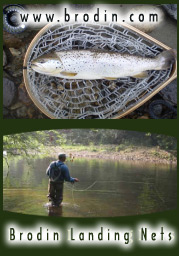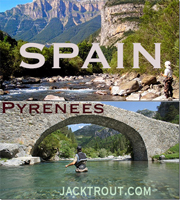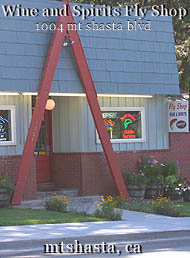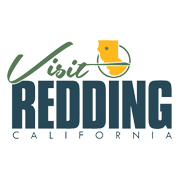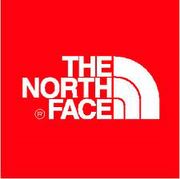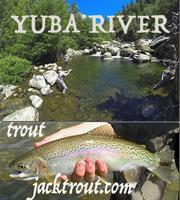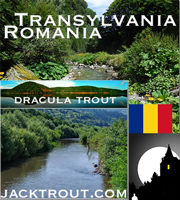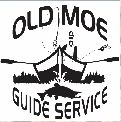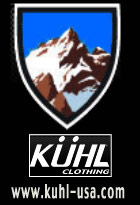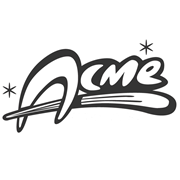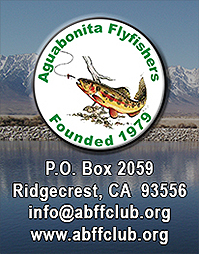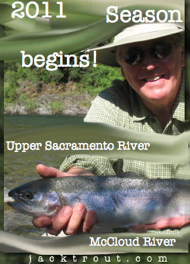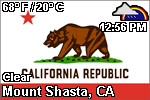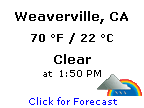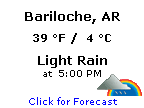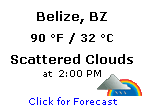*****HAPPY HOLIDAYS! CHILE RIGHT AROUND THE CORNER * STEELHEAD FISHING WILL BE GOOD AFTER THIS NEXT RAIN * I HAVE OPENINGS FOR DEC 18TH THROUGH DEC 23RD!!*****
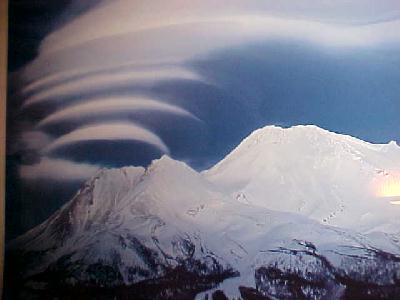
The greatest lenticular cloud ever!

This is Michelle my girlfriend. She and her mother, Jodie, opened the Best Little Hair House, located at 155 Main Street in Weed, California. 530-938-1845
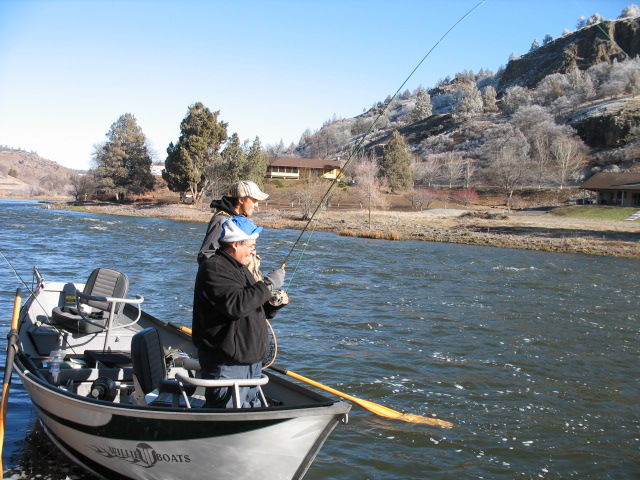
Leonard and Joaquin Santana visited us this past week and enjoyed their adventure on the Klamath. Right off the bat, Leonard hooked into two monsters and fought the second one
like he had done this before–even though he never had! Joaquin cheered his father on as he was on a visit himself from Stockholm, Sweden.
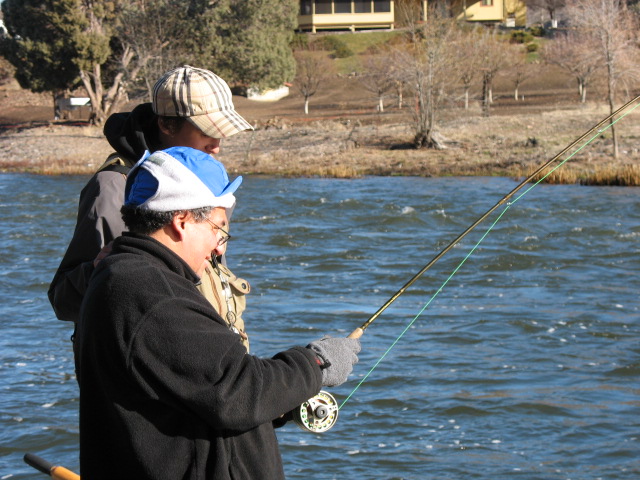
What’s better during the holidays than to be out with dad on the river catching steelhead and sharing memories together
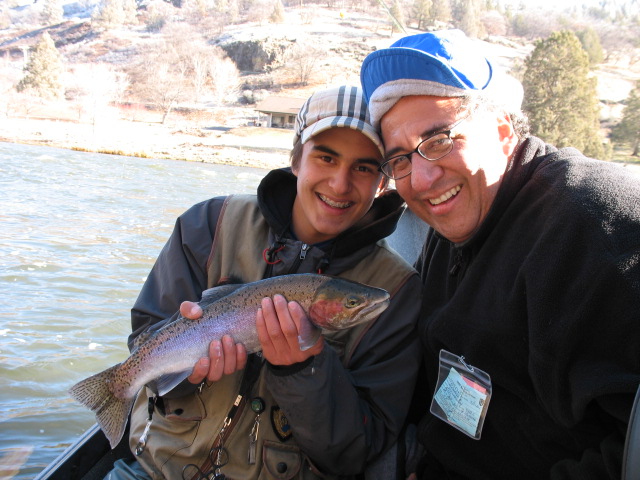
Wow! What a prize for a first catch, POPS! CONGRATULATIONS, YOU’RE MY SIZZLER OF THE WEEK AWARD WINNER! JACK TROUT
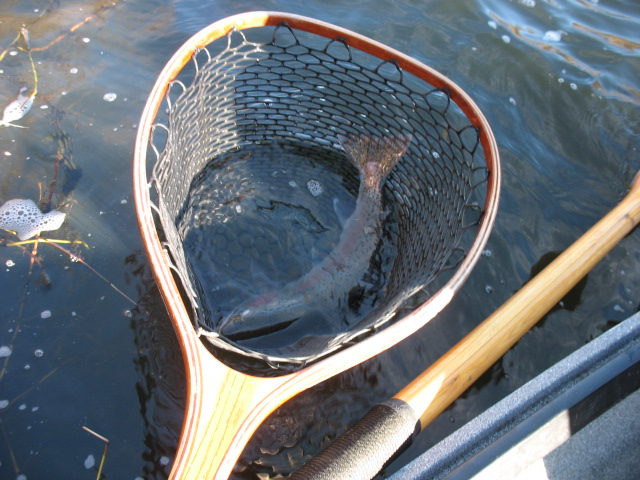
I’ve noticed this year so many of the steelhead we’re catching are wild!
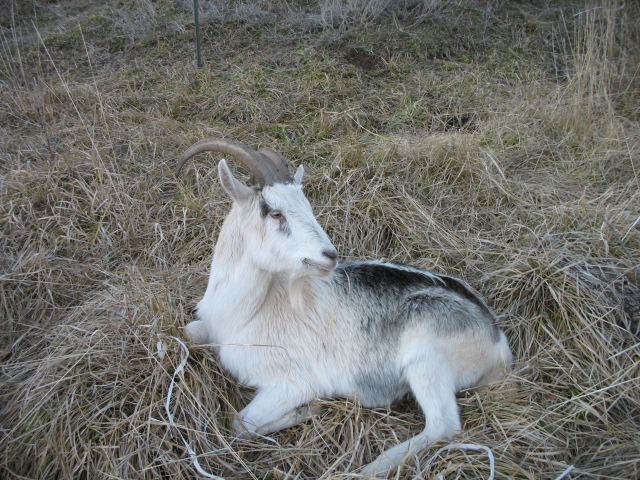
As we looked down river, we could see the Klamathon Bridge up ahead of us which signaled the day was near end. I glanced over to look at the billy goats that are always eating willows and playing along the banks of the river. I noticed a goat tied up in the fencing that looked to be not moving…. I rowed nearer, and saw a back leg move. I went to shore with my hemostats and began untangling horns, legs, and knotted twine.
At first the goat panicked when I got close but completely calmed down as soon as I began cutting the fencing away and talking to the friendly animal. This goat was so lucky–we were the only people on the river that day. It was 36 degrees and 15 minutes from dark. It felt so good to save this goat’s life, catch 14 steelhead and meet Leonard and Joaquin. What a great day indeed! I had that Elton John’s song in my head; Someone saved my life tonight, Sugar Bear! Sweet freedom whispered in my ear! Yea that’s what life’s about, I felt so damn proud of saving that goat’s life it made me think that Shasta Dog must have been watching, smiling, wagging that tail of hers.
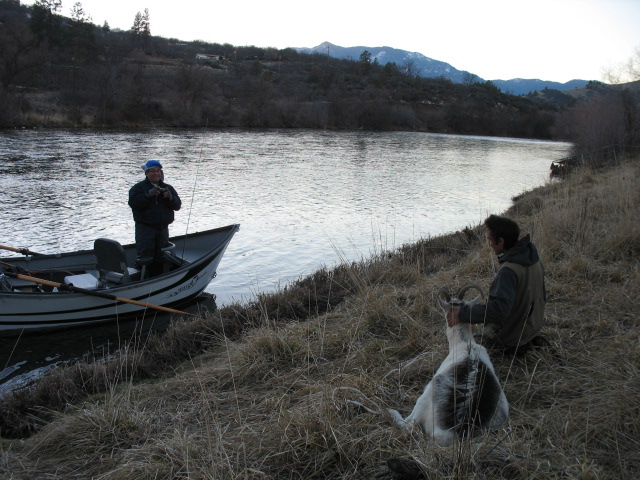
Joaquin was quite humored by the whole event and later I found an apple and we fed the poor dehydrated ram. After about 5 minutes she was like one of the tribe. I named her Mrs. Griffith!
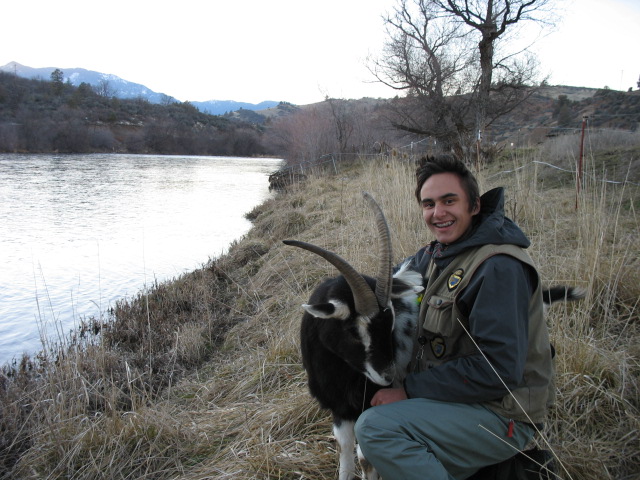
A minute later Oreo came by to take a few bites of the apple.
These were some very nice goats difinitely worth visiting again
(not tied up).
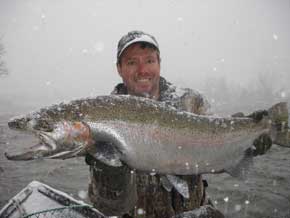
Hello Jack
I don’t want to get into a pissing contest but we have some steelheads in the east as well.
This one was caught today on ther Salmon River in Pulaski,N.Y. I was not the fisher.
Enjoy your photos.
Laurie Swinghammer
Hudson Quebec

To my two best friends in the world: Shasta and Lambchop. It hurt to lose both of you this year but you’ll never be forgotten. Thanks for the great memories and companionship. You’re in my thoughts this holiday season. Thank you for watching my weblog. Sorry to Jack Taylor and Jim Mossop, the pictures on the Trinity and the Klamath were too big to use. I’m buying Photo Suite 7 and I’ll have them up for the next story! Many Rivers To You, Jack Trout
OTHER NOTES:
Restore the Klamath. Fix the World.
Klamath Restoration Council News and Information Network
htt://www.pelicannetwork.net/krc.htm
Posted by Zeke Grader
http://www.sfgate.com/cgi-bin/article.cgi?f=/g/a/2005/12/14/gree.DTL
GREEN Salmon Season
In the Northwest, the fish is of huge economic importance,
which is perhaps the only reason there are any left
Gregory Dicum, Special to SF Gate
Wednesday, December 13, 2005
With winter rains arriving, the region’s rivers and streams are swelling. In
Marin, the increased flow in streams like Lagunitas Creek allows one of the
world’s most magnificent natural cycles — the return of the salmon — to
unfold as it has for millennia.
Narrow streams are starting to be filled with improbably big, red fish, back
in their home waters after three years at sea, fat and ready to breed. In
the midst of our self-absorbed human world, wild nature can still find a way
to hang on. Each year’s return of these fish is a sign of hope, but also a
reminder of how close we are to irreversibly damaging the world around us.
“The most important lesson in ecology is: Everything’s connected,” says
Todd Steiner, director of Salmon Protection & Watershed Network, an
organization that works to protect salmon in the Lagunitas watershed,
which comprises 103 square miles in West Marin, from Woodacre to
Tomales Bay. “We’re trying to repair natural processes by taking a
watershed approach.”
SPAWN employs a combination of research (Steiner is a wildlife biologist by
training), habitat restoration, lobbying, education (including guided public
salmon viewing) and litigation — a microcosm of the activity surrounding
salmon from California to Alaska.
Salmon restoration requires such a multifaceted tool kit because the fish’s
life cycle is so complex, linking land and sea. Each year, baby salmon hatch
in freshwater streams throughout the West. They move downriver as they
grow, before finally transforming themselves into ocean fish.
Several years later (the timing depends on the species), they return to the
exact same stream they were born in and make the arduous journey up to
the headwaters. There, they pair up and spawn in gravel nests before
expiring, exhausted.
The oldest known salmon fossil, from British Columbia, is about 50 million
years old, making this fish a vital part of ocean and terrestrial ecosystems.
“Through the evolutionary process they’re specific to the local conditions —
water temperature, water chemistry, when rainfall happens and so on,”
says Steiner. “They’re all adapted specifically to their location.”
While the thousand endangered coho salmon in Lagunitas Creek don’t go
more than a few miles inland, the nearly two million chinook salmon that
swim through the Golden Gate and into the Sacramento River go hundreds
of miles, into the Sierra foothills and, before the Shasta Dam was completed
in 1945, all the way to Shasta.
The Sacramento is the second-largest salmon-producing river in the lower
48 and is home to nine-tenths of California salmon, despite the loss of 90
percent of its salmon habitat by the 1970s. Salmon are a defining part of
nature here.
“These fish have been important in both the nutritional and spiritual
sustenance of people in the Northwest forever,” Steiner points out, “– as
long as there have been people.”
And modern people in this place are no different: Salmon are of huge
economic importance, which may be the only reason any are left. Salmon
conservation efforts on the Klamath River go back at least to the 1890s.
Fifty years ago, salmon fishermen, seeing the decline of the salmon fishery
in San Francisco Bay, organized and began to call for more comprehensive
conservation measures.
“With salmon, you get involved with just about every possible environmental
issue,” says Zeke Grader, the San Francisco-based executive director of
the Pacific Coast Federation of Fishermen’s Associations.
“I never thought about that when I started doing this 30 years ago, but to
try and protect those fish that our members rely on we’ve worked on
everything from water diversions to dam operations to gravel mining to
pesticides to genetically modified organisms — you name it. I thought,
‘Thank God, at least we don’t have to get involved in air quality issues,’ but
now we’re finding that between mercury deposition in the ocean and
carbon sequestration that we have to start paying attention to that too.”
Mercury released into the air by coal-fired power plants rains into the sea,
where it can accumulate in fish. Eventually it makes its way into the bodies
of people who eat the fish, where it can cause illness.
Grader, whose father was a salmon fisherman and who grew up working in
salmon processing plants, says that salmon fishing is a threatened way of
life. There’s been a decrease of 80 percent in the number of salmon fishing
permits in the past two decades, with fewer than a thousand currently in
California. Each one represents a local small business directly dependent on
a healthy environment.
But now they’re up against agribusiness too. In the past decade, a handful
of Scandinavian multinationals have been setting up salmon farming
operations around the world. Originally a response to exterminated wild
stocks in Norway, these cookie-cutter operations now churn out fish in
British Columbia, Chile and elsewhere. (Salmon farms are not allowed in
California, Oregon and Alaska.)
Farmed fish typically sell for half the price of wild salmon, seriously
threatening the fishermen’s livelihoods. Worse, farmed salmon also threaten
wild fish populations.
“It’s like industrial-scale beef or pig feedlots,” says Sophika Kostyniuk, the
California markets campaigner at the Coastal Alliance for Aquaculture
Reform. “There’s a tremendous concentration of animals being raised in a
small area. They’re fed antibiotics and pesticides if there’s an outbreak of
disease.”
The diseases fostered in these floating nets filled with fish can pass to
nearby wild fish. Worse, farmed fish can escape.
Kostyniuk says that in July more than a million fish escaped during a single
storm in Chile. “Chile didn’t even have an indigenous salmon population,”
adds Kostyniuk, “but now they do.” The invasive Atlantic salmon threaten to
disrupt Chilean river ecosystems, with unknown consequences for native
species.
In places like British Columbia that do have native salmon, farm fugitives,
which are mostly of Atlantic stock, displace the natives that are so finely
tuned to local ecosystems. Juvenile Atlantic salmon have now been found in
Alaskan streams, hundreds of miles from the nearest fish farms in Canada.
Because salmon farming is driven by consumer demand, says Kostyniuk, this
is an area where consumer choice can have instant environmental benefit.
“The most important thing consumers need to do,” she says, “is question
why this fish is being offered to them so cheaply.”
Though CAAR is based in British Columbia, Kostyniuk is in San Francisco
because California is that province’s major farmed-salmon market. More
than 60 percent of the salmon sold in the United States was farmed in
British Columbia or Chile.
“We always encourage people to ask questions to find out where their
salmon is coming from,” says Kostyniuk in her sensible-sounding Canadian
accent. “Just ask in your restaurant or grocery store if it’s wild or farmed.
… I’ve been working on this issue for three years in the Bay Area, and I’ve
just seen such a change in public consciousness of the issue.”
Most recently, the issue has been picked up by chefs around the country.
“Just like vegetables are seasonal, so are fish,” says Chris Cosentino, chef
at Noe Valley’s Incanto. “If it’s in season that’s when it’s at its best — it’s
pretty logical.”
Cosentino notes with disgust that farmed fish are fed dyes to make their
flesh pink. “We serve only local wild salmon,” he adds.
But this year has seen a double whammy for local salmon fishermen. On top
of all their other woes, catches were severely restricted because of
disastrously low salmon populations on the Klamath River three years ago.
The fish were caught in a political battle in which the Bush administration
overallocated the Klamath’s water to farmers, allowing the young fish in the
river to die.
“We got really whacked on our salmon season,” says Grader, the
Fishermen’s representative. “What should have been a very good salmon
season was a bleak one. We figure the losses may have reached or
exceeded $100 million, and it doesn’t look good for the next two years.”
“The tribes on the Klamath really got screwed,” he adds, his voice cracking
slightly. “The pain up there was just tragic.”
In view of these kinds of challenges, every native salmon happily spawning
in the place it was born is a small environmental victory, something that is
not lost on Grader. “Actually things look good in a lot of ways, compared to
the things we’ve been up against,” he says. “What needs to be done is
known. It’s a matter of political will.”
Steiner has faced the same thing in Marin, and the rebounding coho stocks
in the Lagunitas watershed give him hope. “We use the salmon as our
totem species,” he says. “These endangered species are the canary in the
coal mine. The things that we do to protect them protect my children who
play in the creek, and protect the health of the community in general.”
###
http://seattlepi.nwsource.com/local/252001_salmon14.html
Suit wants hatchery fish counted in runs
Wednesday, December 14, 2005 By LISA STIFFLER
SEATTLE POST-INTELLIGENCER REPORTER
Are salmon born in plastic trays the same as those hatched in streambeds?
Absolutely — if you’re part of a coalition of farmers and property rights and
business groups.
No way — if you’re an environmentalist.
And if you’re the government agency responsible for saving vanishing West
Coast salmon runs, the answer is this: Both have value, but they aren’t
created equal.
That debate triggered a lawsuit filed Tuesday in U.S. District Court in
Eugene, Ore., by the Pacific Legal Foundation, a California-based property
rights group.
The suit seeks to have the National Marine Fisheries Service add hatchery
fish to wild populations when considering the health of salmon runs.
Sixteen runs in Washington, Oregon, California and Idaho are protected
under the Endangered Species Act. They include Puget Sound chinook.
“These current listings are illegal,” said Russell Brooks, lead attorney for
the plaintiffs. “We expect the judge to rule that they are illegal and order
that when (the Fisheries Service) goes back and reviews the population
that they must consider all the salmon.”
If that were so, none of the runs would receive federal protection, said
Fisheries Service spokesman Brian Gorman.
Without that protection, restrictions on streamside development could be
weakened, fishing levels increased and limits on pesticide use near
waterways relaxed.
This summer, Earthjustice, an environmental law firm, filed a suit in U.S.
District Court in Seattle challenging a federal policy that looks at wild and
hatchery fish when sizing up their likelihood of survival. Last month, a judge
refused to dismiss the suit, as requested by the Justice Department.
The Pacific Legal Foundation won a ruling in 2001 by U.S. District Judge
Michael Hogan in Eugene that required fishery managers to consider
hatchery salmon numbers when determining whether to list wild stocks as
threatened or endangered.
(In accordance with Title 17 U.S.C. Section 107, this material is distributed without profit to those who have
expressed a prior interest in receiving the included information for research and educational purposes.
Klamath Restoration Council has no affiliation whatsoever with the originator of this article nor is
PelicanNetwork endorsed or sponsored by the originator.)
Klamath Restoration Council
Our mission is to restore and protect the uniquely diverse ecosystem
and promote the sustainable management of natural resources in the entire Klamath River
watershed.
We believe this will be accomplished with actions and legislation that integrate sound and
proven techniques based on tribal knowledge, local experience and the best of Western Science.
http://www.pelicannetwork.net/krc.htm
Mail: Box 214 Salmon River Outpost Somes Bar, CA 95568 Phone: 530 627 3054
Contact: Jack Ellwanger, Klamath Restoration Council Networker
Created by: http://www.pelicannetwork.net/

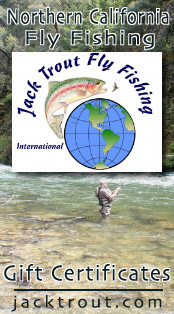
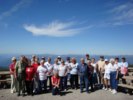
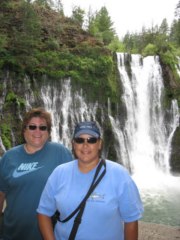
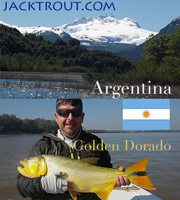


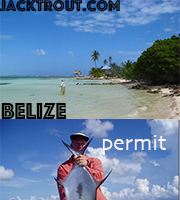
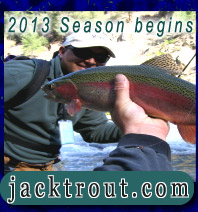
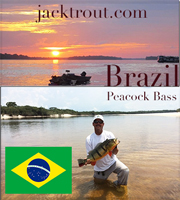
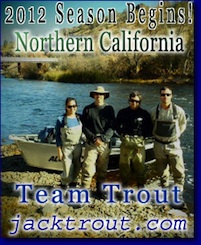
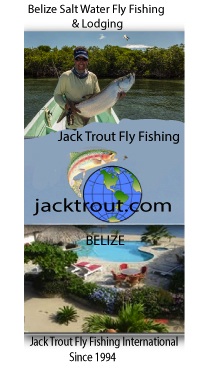
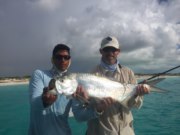
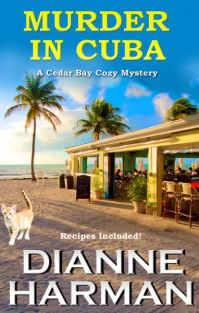
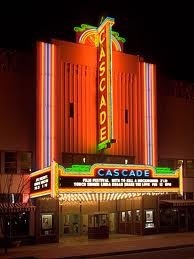

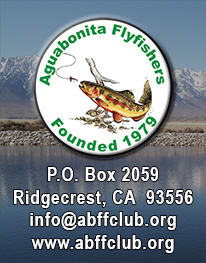
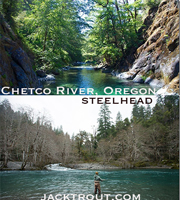
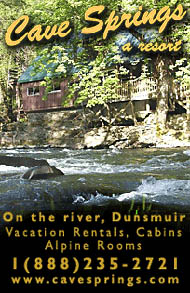



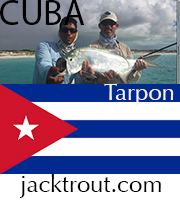


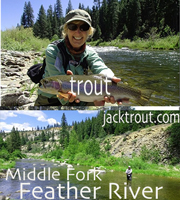
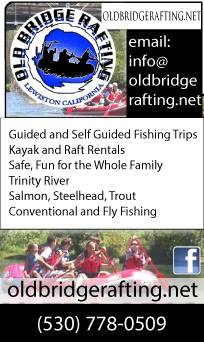


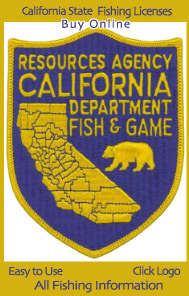

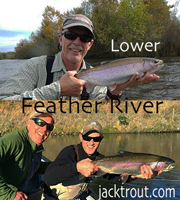
 Mt. Shasta Ski Park
Mt. Shasta Ski Park Shasta.com - Northern CA's premiere business website!
Shasta.com - Northern CA's premiere business website!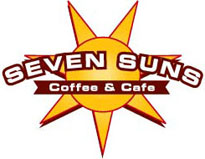
 WEED ALES & BREWERY
WEED ALES & BREWERY 
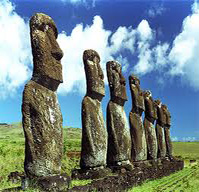 EASTER ISLAND INFORMATION & TOURISM SITE
CHILE!!
EASTER ISLAND INFORMATION & TOURISM SITE
CHILE!! 





